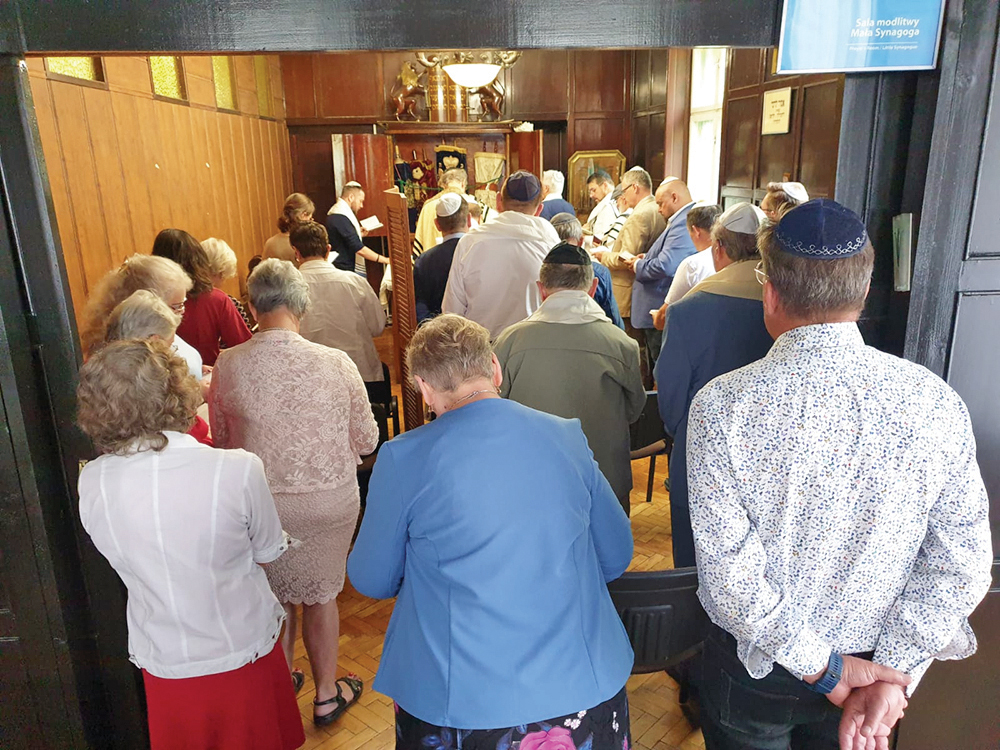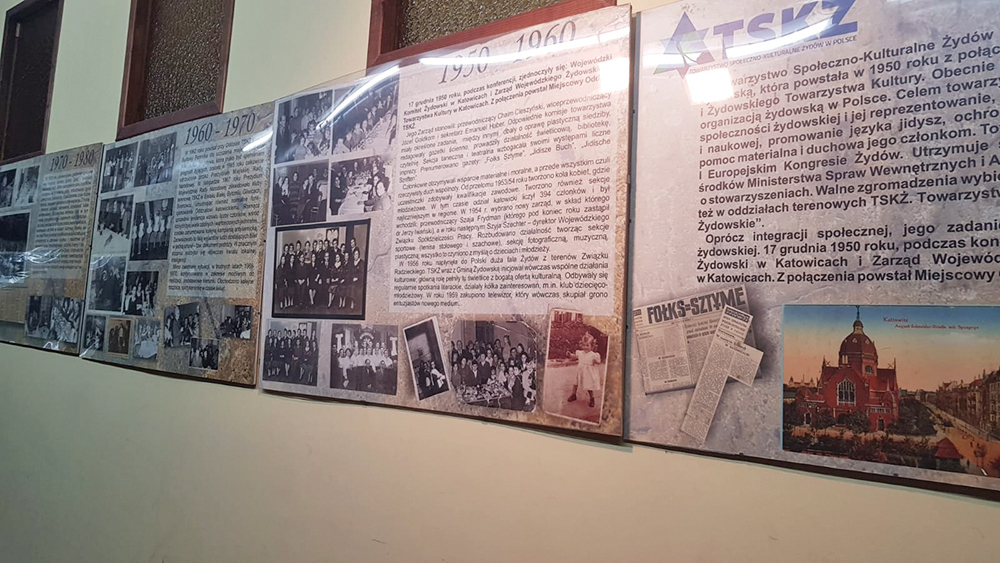
I had an opportunity to attend a once-in-a-lifetime event at an international conference – the conferral of the Deso Weiss Award to my wife, Dr. Isabella Reichel, for excellence in cluttering, one of the important disorders in the field of speech pathology. This award is issued only once every few years to only one individual in the whole world. The catch? The conference was to take place in Katowice, Poland, this year (formerly, Kattowitz), and I didn’t have to be an archeological prodigy to conclude that if I were to attend, I would have to stay in that city and country for Rosh Hashanah.
Upon making inquiries, I ascertained that there still is a Jewish community in Katowice and services held within walking distance—only about 10 minutes on foot. Imagine the hashgacha pratit, the Divine providence, that in an area of about 25,000 square kilometers, the only shul in the entire metropolitan area would be so close to where I had to be! How could we NOT go? But the rabbi I spoke to in June told me he was leaving his position and the community well before Rosh Hashanah, and could not even guarantee a minyan, so he advised me not to come. I then asked for the contact information of the remaining leader of the Jewish community, which led me to Wlodek Kac (pronounced as the more familiar Katz). I presented my credentials to him and offered to lead the services as rabbi, chazzan, Torah reader and shofar blower, having served in all of these capacities in America (though many years ago).
Kac replied excitedly that if he could spread the word that a rabbi from America would be coming, there would almost surely be a minyan. Normally, in his community that he is fighting to preserve, there would barely be a minyan on one day of Rosh Hashanah, if at all, usually the first day, but since the first day this year would fall on Shabbat, with shofar blowing only on the second day, we could have a shot at a minyan both days and even at night. This actually came to pass.
The great Jewish writer Sholem Aleichem (known as “the Jewish Mark Twain”), author of the original story on which “Fiddler on the Roof” was based, famously wrote, “the real pride of Kasrilevka is her cemeteries,” and this was written with irony before the holocaust.
The Jews in Poland who are interred underground number in the millions, but a census of the Jews alive and above ground level ranges from about 3,000 or so affiliated Jews to about 5,000 to 15,000 unaffiliated Jews, with unlimited tourists to holy graves of tzadikim, righteous, going back to near antiquity and to unholy places such as Auschwitz and other sites of iniquity. (Actually, the oldest identifiable Jewish graves in Poland “only” go back about 500 years.)
Nevertheless, visitors to Poland who are interested in touring as individuals are apprised of two links on the Internet—one to a kosher restaurant that takes orders online, and one listing kosher products in Poland. This link fills about 55 pages, in small print, with products organized by category.
In appreciation of my volunteering to lead the services, Kac arranged for my wife and me to be picked up at the airport, served lunch on our arrival in a room decorated by Jewish-themed banners next to a room with a wall full of historic photographs, supplied us with kosher food throughout our trip, and even offered to personally escort us to and from the hotel for each service
I was told that everything about the services, including their duration, would be up to me. I therefore made it clear at the outset that I would defer to the congregants as to every melody they would be familiar with, not that there were many that were apparent to me, and I would chant melodies every time I would reach a section in the service that had been set to music, to the best of my knowledge.
Among the relatively older people there were three relatively young men of note: Witek Jermolowicz, whose knowledge of Judaism has accelerated so fast in the past six years that he is actually applying to matriculate in a yeshiva in New York (he also picked us up at the airport, and provided simultaneous translation of my divrei Torah and comments, and blew the shofar); Slawek Pastuszka had studied with a grandfather and a chazzan as a boy, and spent half a year studying in Israel; and a third young man who is a historian and not counted in the minyan because he is not Jewish, but is often invited to special events so the community can create a Kiddush Hashem and he can convey a positive perspective to the outside world.
Jermolowicz and Pastuszka were actually knowledgeable enough to roll the holy Torah scrolls to the exact points in the text where the appropriate Torah readings for each day were to take place.

There were only three rows of seats on each side of the mechitza, separation, two seats per row, with additional seats added for the occasion, and standing room; however, it was not a guarantee that there would be a minyan, but that is precisely what we did, despite this being unprecedented in recent years. The entire Jewish community serviced by the shul consists of a bit fewer than 100 members at this point.
In my remarks, I tried to emphasize Jewish unity throughout the world, referring, inter alia, to the Daf Yomi, as well as to the melodies of Rabbi Shlomo Carlebach, obm. When I mentioned the Daf Yomi, Witek and Slavek both immediately mumbled in an audible undertone, “Rav Meir Shapiro.” Impressive! The first cycle of the Daf Yomi began on a Rosh Hashanah. I also deliberately pointed out that the Agudath Israel, whose World Congress established the Daf Yomi, had been founded in Katowice, as described by my late father, Rabbi Dr. O. Asher Reichel, in the biography he wrote on the life of Rabbi Yitzchak Isaac Halevy, who united the rabbis of the East with the rabbis of the West for this historic occasion.
The experience had the desired effect, not merely by inspiring people to come for each service, expressing their excitement repeatedly (one old man even kissed me), but more importantly it energized the participants and galvanized the leadership to hire a rabbi from Israel and aim for actual minyanim on Yom Kippur, and hopefully for the participants to be more active in the future.
As small as the Jewish communities in Poland may be, especially in Katowice, their influence is absolutely astonishing. Kac in Katowice, and others elsewhere in Poland, are solemnly dedicated to preserving the millions of Jewish graves in their midst, and making sure that the real estate associated with the Jewish cemeteries will not be sold or used for other purposes. In addition, the Jewish community exports a tremendous amount of kosher products to America, Israel and other destinations throughout the world.
The stopover of our flight back to New York, at Warsaw, intersected with many chassidim filling the majority of a plane returning from their annual pilgrimage to Uman, in the neighboring war-torn Ukraine. They were so energized that they even applauded at takeoff, not just upon landing, and some of them sang and chanted at points along the way. The spiritual energy I felt, and hopefully transmitted, during, before and after Rosh Hashanah merged the two missions l’hagdil Torah u’le’ha-adira, to glorify and honor the Torah, and all it stands for.
Rabbi Reichel, a New York attorney, author, and editor, previously led parts of the High Holiday auxiliary services at the Fifth Avenue Synagogue in New York City, and parts of the primary services in Massachusetts, in Brooklyn, and in a Manhattan nursing home, all decades ago.












